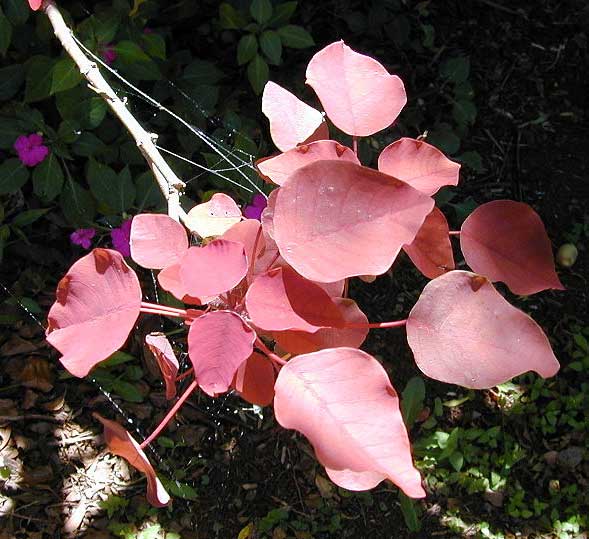
Euphorbia cotinifolia, (Photo: Forest & Kim Starr)
Classification System: APG IV
Superregnum: Eukaryota
Regnum: Plantae
Cladus: Angiosperms
Cladus: Eudicots
Cladus: Core eudicots
Cladus: Rosids
Cladus: Eurosids I
Ordo: Malpighiales
Familia: Euphorbiaceae
Subfamilia: Euphorbioideae
Tribus: Euphorbieae
Subtribus: Euphorbiinae
Genus: Euphorbia
Subgenus: E. subg. Chamaesyce
Sectio: E. sect. Alectoroctonum
Species: Euphorbia cotinifolia
Subspecies: E. c. subsp. cotinifolia – E. c. subsp. cotinoides
Name
Euphorbia cotinifolia L., 1753
Synonyms
Homotypic
Tithymalus cotinifolius (L.) Haw., Syn. Pl. Succ.: 141 (1812).
Alectoroctonum cotinifolium (L.) Schltdl., Linnaea 19: 252 (1846).
Aklema cotinifolia (L.) Millsp., Publ. Field Columb. Mus., Bot. Ser. 2: 416 (1916).
Distribution
Native distribution areas:
Continental: Southern America
Regional: Trop. America
Bolivia; Brazil North; Cayman Is.; Colombia; Costa Rica; Dominican Republic; Ecuador; El Salvador; French Guiana; Guatemala; Guyana; Honduras; Leeward Is.; Netherlands Antilles; Nicaragua; Panam; Peru; Puerto Rico; Southwest Caribbean; Suriname; Trinidad-Tobago; Venezuela; Windward Is.
Continental: Northern America
Regional: Mexico
Mexico Central; Mexico Gulf; Mexico Northeast; Mexico Northwest; Mexico Southeast; Mexico Southwest
References: Brummitt, R.K. 2001. TDWG – World Geographical Scheme for Recording Plant Distributions, 2nd Edition
References
Primary references
Linnaeus, C. 1753. Species plantarum, exhibentes plantas rite cognitas, ad genera relatas, cum differentiis specificis, nominibus trivialibus, synonymis selectis, locis natalibus, secundum systema sexuale digestas. Tomus I. Pp. [I–XII], 1–560. Impensis Laurentii Salvii, Holmiae [Stockholm]. BHL Reference page. : 453.
Links
Govaerts, R. et al. 2020. Euphorbia cotinifolia in Kew Science Plants of the World online. The Board of Trustees of the Royal Botanic Gardens, Kew. Published online. Accessed: 2020 Jun 25. Reference page.
International Plant Names Index. 2020. Euphorbia cotinifolia. Published online. Accessed: Jun 25 2020.
Govaerts, R. et al. 2020. Euphorbia cotinifolia in Kew Science Plants of the World online. The Board of Trustees of the Royal Botanic Gardens, Kew. Published online. Accessed: 2020 Jun 25. Reference page.
Tropicos.org 2020. Euphorbia cotinifolia. Missouri Botanical Garden. Published online. Accessed: 24 Jun 2020.
USDA, ARS, Germplasm Resources Information Network. Euphorbia cotinifolia in the Germplasm Resources Information Network (GRIN), U.S. Department of Agriculture Agricultural Research Service. Accessed: 08-Apr-12.
Vernacular names
Ελληνικά, Κυπριακά: Ευφόρβια η κόκκινη
English: Red Spurge
español: Euforbia roja
Euphorbia cotinifolia is a broadleaf red shrub native to Mexico and South America. Treated as a shrub, it reaches 10 to 15 ft (3.0 to 4.6 m) but can be grown as a tree reaching 30 ft (9.1 m). Small white flowers with creamy bracts bloom at the ends of the branches in summer. The purplish stems, when broken, exude a sap that is a skin irritant.[1]
The scientific name of the plant comes from the words cotinus meaning "smoketree" and folia meaning "leaf".[2] Common names for the species include smoketree spurge, tropical smoke bush, Caribbean copper plant,[3] and Mexican shrubby spurge.[4]
Toxicity
The species is well known in Central America, where its poisonous sap has been used both as a medicine and a poison. As a medicine, it has been used in folk remedies as both an emetic and cathartic substance. Fishermen have been known to add the sap to water in fishing grounds to stun fish and force them to float to the top. It was also historically used as a poison for arrowheads by the natives of Curaçao.[5]
The sap can cause irritation if it comes into contact with human skin or eyes.[6] If ingested, the sap can cause severe damage to internal organs.[5]
Gardening
Euphorbia cotinifolia is commonly grown as an ornamental plant in gardens and in pots, due to its colourful and distinctive foliage. It prefers a site with well-drained soil and full sun. While relatively hardy, it does not react well to wind, salt, or frost.[7]
References
Nelson, Lewis S.; Shih, Richard D.; Balick, Michael J. (2007). Handbook of Poisonous and Injurious Plants (2nd ed.). Springer. p. 162. ISBN 978-0-387-33817-0.
"Euphorbia cotinifolia". Missouri Botanical Garden. Retrieved 30 December 2012.
"Euphorbia cotinifolia (Tropical smoke bush, Caribbean copper plant) - Fine Gardening Plant Guide". Retrieved 30 December 2012.
USDA, NRCS (n.d.). "Euphorbia cotinifolia". The PLANTS Database (plants.usda.gov). Greensboro, North Carolina: National Plant Data Team. Retrieved 26 April 2015.
Clay, Horace F.; Hubbard, James C.; Golt, Rick (1987). Tropical Shrubs Paper. University of Hawaii Press. p. 72. ISBN 978-0-8248-1128-0.
Nelson, Lewis S.; Shih, Richard D.; Balick, Michael J. (2007). Handbook of Poisonous and Injurious Plants (2nd ed.). Springer. p. 162. ISBN 978-0-387-33817-0.
Weissich, Paul R.; Rauch, Fred D. (2000). Plants for tropical landscapes: a gardener's guide. Honolulu: University of Hawai'i Press. p. 50. ISBN 978-0-8248-2034-3.
Retrieved from "http://en.wikipedia.org/"
All text is available under the terms of the GNU Free Documentation License

